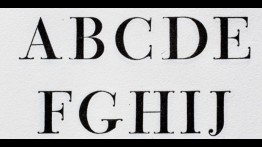A Critical Appreciation of Bodoni’s Romans and Italics
Monday, November 15, 2021, 12:30 - 2:30pm

Since his death in 1813, much has been written about Giambattista Bodoni. While Anglo-saxon historians have tended towards severe criticism of his types – we remember William Morris’s extreme and unwarranted pontification “[…] the sweltering hideousness of the Bodoni letter” – the Italians have often gone in the opposite direction, as in the case of Franco Maria Ricci who talks of the “melancholic intimacy” and “magic” of Bodoni’s typefaces. What has been missing until recently is a real analysis of Bodoni’s typographical output. In this talk as part of the Herb Lubalin Lecture Series, James Clough will discuss Bodoni’s romans and italics (and other species of his latin types) within the historical and artistic context of his times. His types will be compared with those of Pierre Simon Fournier, who greatly influenced him; the talk will also consider Bodoni's development of the “modern” face in relation to Didot. While Bodoni showed amazing dexterity in the very rare art of punchcutting and the refined elegance of some of his typefaces, the talk does not not shirk from investigating some of the more puzzling and shadier areas of his production, especially in the light of certain psychological considerations.
Following his training in typographic design at the London College of Printing, James Clough moved from London to Milan in 1971 and pursued a career in typography, lettering and calligraphy. For the past thirty years he has deepened his knowledge of the history of type and the graphic arts and he has lectured on these subjects in Italy and various European countries as well as the USA. Besides his many articles and lectures on Bodoni, Clough is the author of Alphabets of Wood, a history of Italian wood type, and Signs of Italy. From 2016 to 2019 the Italian newspaper La Repubblica published his Sunday column on historical and modern Italian inscriptions and signs. Earlier this year, as a member of the Nebiolo History Project, he gave a talk for the Herb Lubalin Lecture Series on Microgramma and Eurostile.




